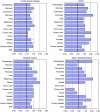A 50% higher prevalence of life-shortening chronic conditions among cancer patients with low socioeconomic status
- PMID: 20978508
- PMCID: PMC2994221
- DOI: 10.1038/sj.bjc.6605949
A 50% higher prevalence of life-shortening chronic conditions among cancer patients with low socioeconomic status
Abstract
Background: Comorbidity and socioeconomic status (SES) may be related among cancer patients.
Method: Population-based cancer registry study among 72,153 patients diagnosed during 1997-2006.
Results: Low SES patients had 50% higher risk of serious comorbidity than those with high SES. Prevalence was increased for each cancer site. Low SES cancer patients had significantly higher risk of also having cardiovascular disease, chronic obstructive pulmonary diseases, diabetes mellitus, cerebrovascular disease, tuberculosis, dementia, and gastrointestinal disease. One-year survival was significantly worse in lowest vs highest SES, partly explained by comorbidity.
Conclusion: This illustrates the enormous heterogeneity of cancer patients and stresses the need for optimal treatment of cancer patients with a variety of concomitant chronic conditions.
Figures


References
-
- Ayanian JZ, Zaslavsky AM, Fuchs CS, Guadagnoli E, Creech CM, Cress RD, O’Connor LC, West DW, Allen ME, Wolf RE, Wright WE (2003) Use of adjuvant chemotherapy and radiation therapy for colorectal cancer in a population-based cohort. J Clin Oncol 21: 1293–1300 - PubMed
-
- Berkman LF, Macintyre S (1997) The measurement of social class in health studies: old measures and new formulations. IARC Sci Publ 138: 51–64 - PubMed
-
- Bos V, Kunst AE, Mackenbach JP (2000) Nationale gegevens over sociaal-economische sterfteverschillen op basis van informatie over kleine geografische eenheden. Verslag aan de programmacommissie Sociaal-economische gezondheidsverschillen II. Instituut Maatschappelijke Gezondheidszorg, Erasmus Universiteit: Rotterdam
-
- Bos V, Kunst AE, Mackenbach JP (2001) De omvang van sociaal-economische sterfteverschillen gemeten op buurtniveau: vergelijking met schattingen op basis van informatie op individueel niveau. In Sociaal-economische gezonheidsverschillen: Van verklaren naar verkleinen, Stronks K (ed) Vol. 5, pp 8–20. Zon/MW: Den Haag
-
- Bueno-de-Mesquita HB, Ferrari P, Riboli E (2002) Plant foods and the risk of colorectal cancer in Europe: preliminary findings. IARC Sci Publ 156: 89–95 - PubMed
Publication types
MeSH terms
LinkOut - more resources
Full Text Sources

